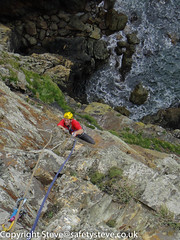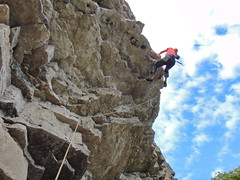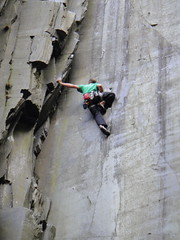Gogarth Red Walls has always been one of my favourite climbing venues. Access is limited due to bird nesting restrictions, but in the autumn its a special place and usually quite well protected from the wind.Bank Holiday Monday was my last chance to climb before setting off to Nepal later this week to help train some Nepalese trek leaders with the Nepal Mountaineering Association. This is another partnership project with the Petzl Foundation, with the long term aim of helping the NMA achieve UIAA accreditation under the UIAA Training Standards.
Tuesday, 30 August 2011
Sunday, 21 August 2011
Climbing at Llandudno
Despite an encouraging weather forecast it rained almost all day in Llanberis. Mike Pycroft and I drove to Llandulas but it was raining there as well - however it had seemed brighter as we passed Llandudno. Sure enough we found a sun trap at the Empire Crags. Upper Empire is bolted but inherently unstable; Lower Empire has some great roof climbing, generally with good holds between the overlaps. This pitch is very impressive for the grade, and great fun! Highly recommended.
Monday, 15 August 2011
Fantasia
A sunny day at last! Pete Johnson and I followed up a tip-off that Gogarth was dry and headed over to my favourite crag: the Red Walls. This sandstone bastion has a notorious reputation as an "acquired taste" but once it gets under your skin (and in your hair!) there's no finer place for a day's adventure. To our surprise the crag was quite busy, though as usual we knew most of the others already. We started off with the ultra-classic Fantasia, and then got a bit lost on Redshift and decided to escape up a neighbouring, obvious line up a continuous corner. I got it into my head that this was a notorious corner line named Khmer Rouge, so spent the entire journey expecting hard moves to appear. It was pretty sustained but never too hard, so back at the car we hit on the bright idea of looking at the guidebook (we had both climbed Redshift before and each assumed the other remembered where it went!) Turns out it was the correct line after all, though actually the guidebook description could be improved. I've sent some suggestions to Groundup, who are publishing the next edition of the Gogarth South Stack guidebook
Don't bother rushing over again just yet though: 24 hours later the rains returned.
A week later we abseiled back down the line to check our hypothesis (correct), and climbed out via a route that I climbed with Chris Parkin in 1988 on the first ascent. Since then the piton that protected the strenuous crux has rusted away, but the climbing follows cracks and is well protected anyway. Named Dangerous Liason, it is technically harder but better protected than most of the other routes on the wall.
Don't bother rushing over again just yet though: 24 hours later the rains returned.
A week later we abseiled back down the line to check our hypothesis (correct), and climbed out via a route that I climbed with Chris Parkin in 1988 on the first ascent. Since then the piton that protected the strenuous crux has rusted away, but the climbing follows cracks and is well protected anyway. Named Dangerous Liason, it is technically harder but better protected than most of the other routes on the wall.
 |
| Steve leading Dangerous Liason, Red Wall, Gogarth |
Tuesday, 9 August 2011
Anarchy in the UK
It's been shocking to see the wave of looting that has spread across England lately though sadly I have to say I'm not entirely surprised - all the right ingredients for anarchy have come together recently as a pseudo-justification for anybody who wants an adventure on the streets. It's up to the government, the press, the Metropolitan police, the banks etc to regain their moral authority, but there's something that can be done to help young people find adventure and challenge in socially acceptable ways: adventure education. Not dumbed-down "adrenaline fixes" but real adventure based on learning skills and matching them to challenges and peer groups. Its no wonder that climbing walls are so popular, but there's so much more that could be done with better funding for bouldering venues and coaching at the realistic level for young people to continue developing outside "taster" sessions - bouldering ticks a lot of boxes for example - sociable, cheap, exciting and pointless, just like all the important things in life.
First aid requirements for Mountain Leader Training qualifications.
This is a piece that's hidden away on the old news section of the MLTUK website but I think it gives some important and useful information, therefore worth adding to this blog as well.
We are regularly getting asked for advice on first aid requirements, so here's a statement from the chief officer. We don't police this, so it is up to the assessor (and candidate) to satisfy him or herself that the first aid course fits the criteria. Some people use the awards in more remote places than others so we just specify the minimum requirement. For the WGL, for example, the remit criterion is that the area is easily exited within a few hours, so prolonged casualty care is less likely than for an ML holder. When there is any doubt they contact us and we simply go through the syllabus requirements, extracted below. So you can assure your participants that the course meets the criteria required by the Boards if you can go through the syllabus tick list (which is very open as you can see) and agree that it matches all points.
FIRST AID REQUIREMENTS
For any leader, First Aid is an essential skill and our assessments require a current first aid qualification. The minimum requirement for the outdoor schemes is that such a course must involve at least two full days or sixteen hours of instruction and include an element of assessment. Candidates are further expected to undertake such additional elements of first aid training as are consistent with their work in wild and remote country, including emergency assistance and evacuation techniques. It is the responsibility of award holders and/or their employers to evaluate their likely work and the type of situations that they can reasonably expect to encounter and to maintain current appropriate first aid training and qualifications.
In addition, here are some specific items to be covered:
First aid training is about risk management, so the trainer needs to cover the sort of things that are more likely to go wrong on the hill. Given the restricted time available, incidents such as poisoning through industrial cleaning fluid, for example, would be a low priority topic for WGL candidates whereas environmental injuries such as heat or cold exhaustion, or even drowning, would be much higher up the list. This is the sort of thing that is sometimes best done by getting the candidates to brainstorm everything that could go wrong on an expedition, and write up the topics that require specific first aid training for the first aid course. In addition to primary and secondary care, casualty examination and basic “ABCDE” life support I would certainly expect the following to be covered (not an exhaustive list!):
- Calling for help
- Methods and limitations of evacuation
- Common conditions, e.g. asthma, epilepsy, angina and diabetes
- Cold injuries inc. hypothermia and frost nip/bite
- Heat injuries inc. burns, heat exhaustion, heat stroke, blisters, dehydration
- Drowning/near drowning
- Electric shock (lightning for example)
- Bites and stings, inc. sheep ticks.
- Substance abuse and poisoning
Finally, I would recommend that the course should be as "hands on" in emphasis as possible, keeping lecture style to a minimum and group participation to a maximum. First aid training should be about building skills and confidence first, knowledge second.
Monday, 8 August 2011
Climbing on the North Wales coast
This is a recent and excellent addition to the wealth of sports climbing on the North Wales coast, put up recently by local activist Jon Radcliffe and graded at 6c+ thanks to a strenous approach to a fingery crux right at the top. The impressive arete to the right is a highly acclaimed 7c that has received rave reviews.
The nearby Cigfran Wall is also well-worth a visit, offering an interesting journey at 6b up a 30 metre wall and some shorter neighbouring routes. With a delightful approach walk along an abandoned quarry track and a seaward aspect, this area provides a great day out.
Friday, 5 August 2011
Multi-pitch sport climbs in Twll Mawr, Llanberis slate
Dodgy weather this week so Mike Pycroft and I nipped out twice after work to the slate quarries, which dry relatively quikly to tackle a couple of enjoyable multi-pitch new routes from Ian Lloyd Jones, weighing in at 7a and 7a+ respectively. Great additions to the quarries and clearly a lot of work involved in equipping the lines. Both routes are logical contenders for sport routes, as the rock is quite friable and traditional protection would fail.
Both routes have very difficult cruxes that are much harder than the rest of the routes; indeed I would suggest that a more enjoyable experience can be had in both cases by just climbing the top 60 metres (at perhaps 6b+ and 6c+ respectively).
This photo shows the key to the crux of Super Massive Black Hole. This took me ages to work out, not helped by pulling off the left hand hold in this photo! Or by the pool of water in the borehole pocket that kept spilling over onto the high toehold.
Tim Neill found this sequence easy but he bridged up it - my leg span is half a metre less so this wasn't an option though I did practically dislocate my hip trying! so a high rock-over on the right wall is the answer for most mortals combined with walking your hands up the left wall. Typical slate weirdness. We topped out as darkness and drizzle arrived. The party behind us (a dusk start!?) were not so lucky but were able to escape through a tunnel near the first stance
Wednesday, 3 August 2011
Update on coaching climbing qualifications development
 |
| BMC officers throwing some shapes |
Earlier in the year MLTUK formed two separate small teams drawn from across the whole of the UK and Ireland in order to provide management and technical support to the development of a coaching qualifications pathway. This has allowed each group of specialists to focus on a specific area of this exciting project, and at the beginning of August we have now reached a good level of consensus of the syllabus contents for levels 1 (Assistant Coach) and level 2 (Coach). These will be submitted to the MLTUK Board at the forthcoming meeting at Plas y Brenin on September 17th 2011.
The scheme will be designed for wall and sport climbing and in the case of national coaches it will use existing qualifications such as the CWA to guarantee good safety management (local coaches who only operate within one wall may well be signed off as technically competent via in house accreditation). In time there may also be a level 3 coach and the work now turns towards discussing and agreeing delivery mechanisms, accrediting prior learning and training providers.
John Cousins at MLTUK said ‘with the safety of participants covered through existing awards the requirements for each syllabus are more about quality of delivery, and the working groups have done very well to agree the minimum standards’.
Neil Gresham commented to Steve Long, the project coordinator: ‘I couldn't agree more that we're making progress. I can also see a future for mapping my coaching activities in with the proposed scheme. This really is excellent news.’
Graeme Morrison the new Chair of MLTS said ‘For me the progress and effort Steve has put in is very good and the resulting draft syllabi excellent. I have a support network including sports scotland coaching staff and Abertay Uni specialists and they say we are well on the way to developing a sustainable coaching format for climbing and mountaineering.
Membership of the advisory groups is as follows:
Management Group: Nick Colton (BMC), John Cousins (MLTUK), Rosie Goolden (MCofS), Steve Long (MLTUK), Mike Pinder (BMC)
Technical Group: Dave Binney, Angela Carlin, Martin Chester, Ian Dunn, Jon Garside, Neil Gresham, Steve Long, Graeme Morrison
Steve Long
Subscribe to:
Posts (Atom)





